How Long Does Soup Last, and How to Store and Reheat It
Here’s all you need to know about the shelf life, spoilage, and storage of soup. Learn how long soups last, how to store them, and how to tell if yours is spoiled.
So you’ve cooked a big pot of soup and are wondering how many days you can store the leftovers. How long does soup last in the fridge?
Or maybe the quality of yours seems iffy, and you’d like to know how to tell if your soup is bad.
Want to learn a thing or two about storage, shelf life, or going bad of all sorts of soups? If so, this article is for you.
Read on.
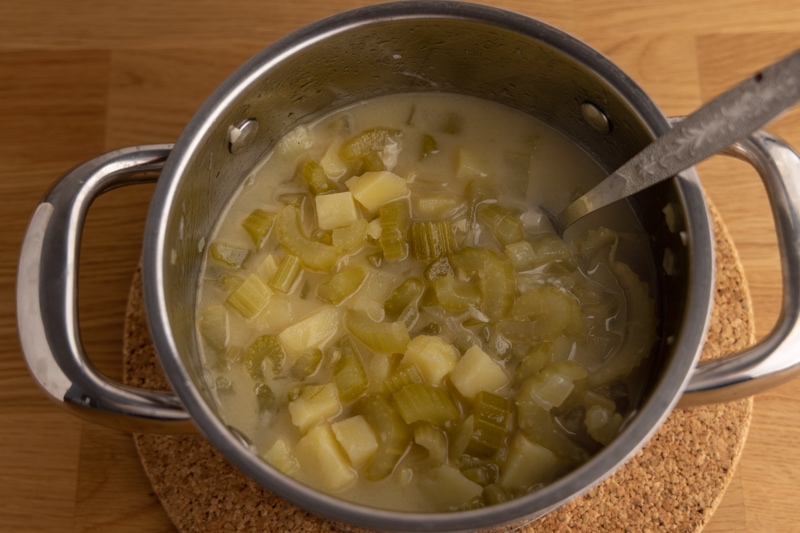
How Long Does Soup Last in the Fridge?
Soup lasts 3 to 4 days after cooking if you store it in a resealable container or lidded pot in the fridge. If that’s not long enough for your needs, you can freeze most soups.
Of course, some recipes suggest you refrigerate the cooked soup for up to a week, but I suggest you stick with the 3 to 4 days recommended by the USDA. That’s a much safer approach.
I also found a few sites saying that fish and seafood soups last only a day or two, but I couldn’t find any reliable source to back up that claim. Plus, I don’t see why a fish chowder soup shouldn’t last as long as creamy broccoli soup does.
Furthermore, you can store cooked fish and seafood for 3 to 4 days, so I don’t see a reason your soup with similar ingredients shouldn’t last that long, either.
Anyway, if those short 3 to 4 days aren’t enough for your needs, consider freezing the soup. Not all soups freeze particularly well, but many do. Or you can freeze your chicken broth, bone broth, or any other broth you use as a soup base.
(I cover freezing in much more detail later in the article.)
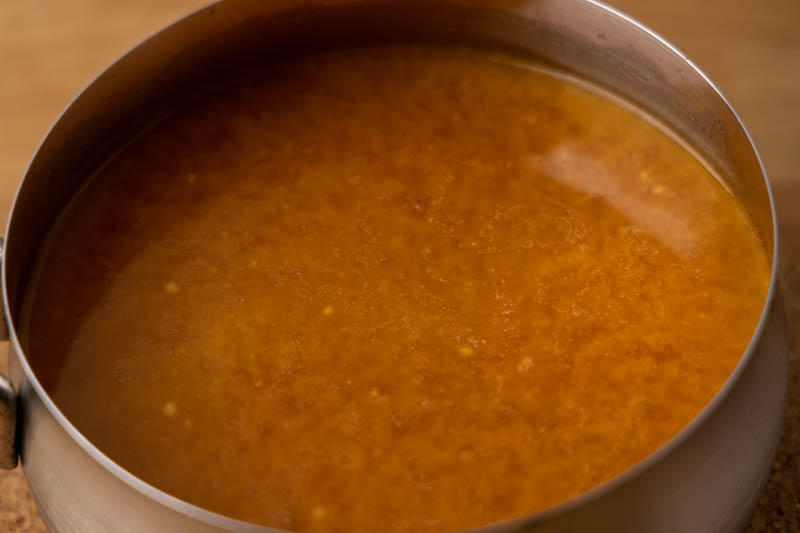
How to Tell if Soup Is Bad?
Discard your soup if:
- You store it for more than four days. Leftover soups stay safe to eat for only 3 to 4 days in the fridge. If yours sits longer, assume it has spoiled and toss it. If you cooked a big pot of soup, freezing the leftovers is usually a much better option than hoping the soup will stay fine for an extra day or two.
- It smells off or sour. Give the soup a good whiff, and if you notice that it has turned sour, that’s a sure sign it’s no good. If the soup is pretty sour by design (e.g., it’s sauerkraut soup), you’ll probably need to taste it to make sure. In that case, it’s going to be difficult to tell if it has turned sour by smell alone.
- There’s mold on the surface. If the liquid doesn’t fully cover the veggies, pasta, or meat in the pot or container, they might grow mold. If that’s the case, the soup is no good. Trying to scoop the moldy part and eating the rest is a bad idea. Also: remember to ensure all the veggies, pasta, rice, and what have you are well covered by the liquid when storing soup.
- The flavor has changed. Taste the soup before serving it, and be on the lookout for any signs of sourness, funkiness, and other off flavors. In most cases, it’s going to be obvious that there’s something wrong with it. That’s when you toss the soup.
Okay, those are the typical signs of spoiled soup.
Besides that, there might be a couple of things that some find concerning but are actually perfectly fine.
What’s Okay
First, thick soups tend to thicken in storage. So don’t be surprised if you can eat your creamy soup with a fork the next day.
To fix that, add some water, broth, milk, half and half, or whatever else makes sense to make it thinner, and you’re good to go.
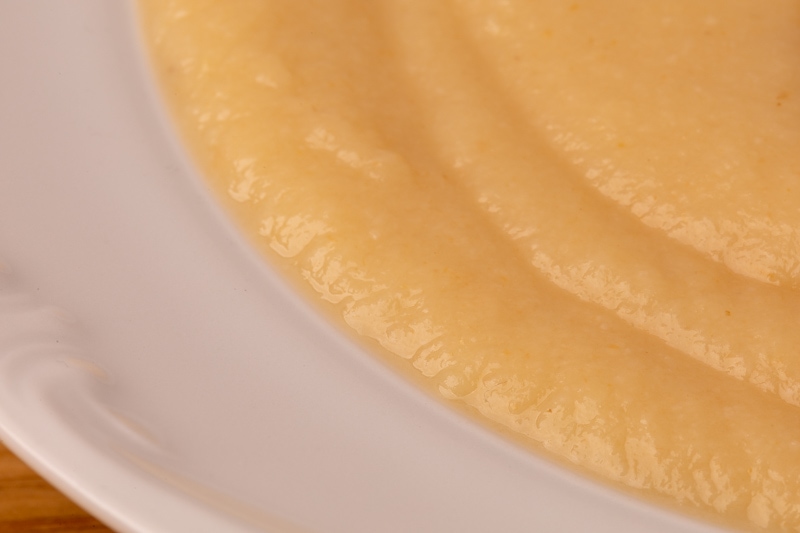
Next, your soup might become too salty after reheating.
Reheating results in water loss. That means the salt content stays the same, but the water content drops, resulting in a more salty liquid.
To make up for it, you can add water, but don’t go overboard, as this will also thin it out. Also, postpone salting the soup until after it’s reheated.
Last, expect pasta will become mushy after reheating.
If you’re reheating soup with pasta already in the pot, try to keep the reheating time to a minimum. That’s because that’s basically trying to cook cooked pasta for the second time, resulting in overcooked, mushy pasta.
A better approach if you expect leftovers is to cook pasta and soup separately and only combine them when plating the soup. This way, you cook the pasta once, and there’s no mushiness to worry about.
If you notice anything else about the soup that seems off, trust your gut and toss the soup. Better safe than sorry.
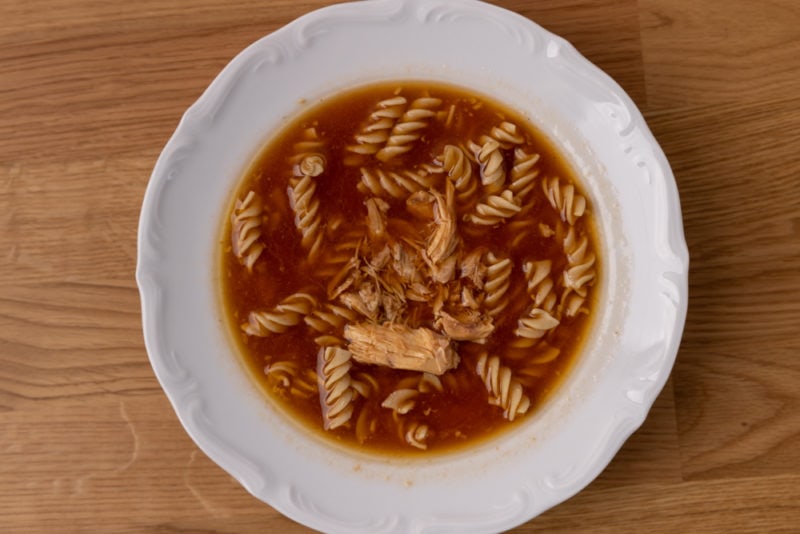
How to Store Soup
Your leftover soup should be refrigerated in a resealable container or lidded pot and used within 3 to 4 days of cooking it. If that’s not long enough, often, you can freeze it.
Before you transfer the soup to the fridge, cool it quickly at room temperature so that the pot doesn’t warm up other foods and the refrigerator doesn’t have to work overtime to cool it down.
And make sure the cooldown period isn’t longer than two hours, as that’s about how long perishable foods can sit at room temperature before they become unsafe. That guideline is otherwise known as the 2-hour rule.
The easiest way to cool a large amount of soup quickly is to divide it into several large shallow containers or soup plates. Divided this way, the soup should cool to about room temperature in half an hour or so.
To speed up the cooldown process, stir the soup every now and then.
Finally, if your soup is loaded with veggies, pasta, or what have you, make sure everything is covered by liquid. This way, there won’t be any mold growing on the parts that aren’t covered with liquid.
(It’s similar to keeping your sauerkraut submerged in brine, though brine keeps the food safe for much longer than 3 to 4 days.)
That’s about it when it comes to storing soup in the fridge. Next up, let’s talk about freezing leftover soup.
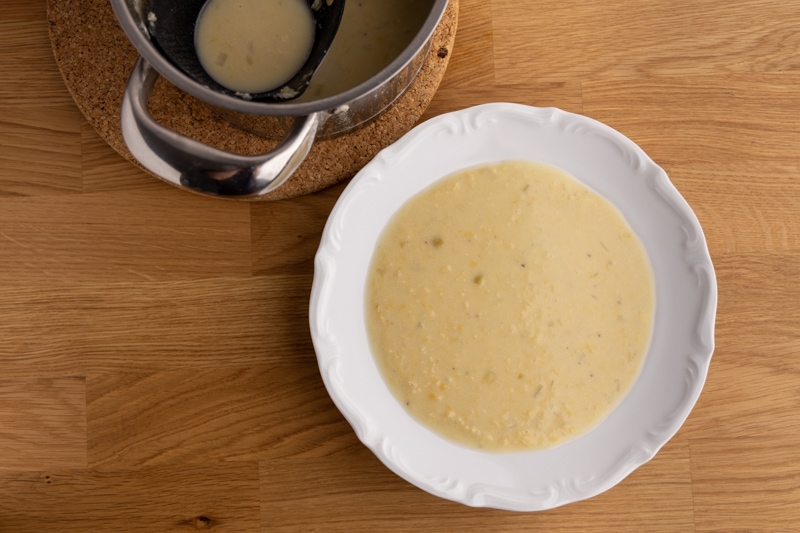
Freezing Soup
Freezing is the best and easiest way to prolong soup’s shelf life.
The only downside is that only some soups freeze well, and it’s usually better to know upfront if you’re going to freeze the leftovers or not. That’s because you might want to modify the recipe a bit or postpone adding certain ingredients if that soup is to be frozen.
Let’s discuss the details.
Can You Freeze All Soups?
Technically speaking, you can freeze all soups. But some soups don’t freeze well and what you get after defrosting and reheating is a far cry from what that soup was fresh. Fortunately, you can often adjust the recipes or the cooking process to make the soup freezer-friendly.
Here are the most popular examples.
Soups with cream, milk, etc.
These soups tend to separate and curdle after freezing and defrosting, and simple reheating and stirring the soup won’t quite fix those issues.
(Check out what sour cream looks like after freezing and defrosting if you’re interested.)
That said, the quality typically isn’t a huge deal if you only use a bit of cream just to whiten the soup. But if the dairy product is one of the main ingredients, that’s when you run into quality issues after defrosting.
The fix is simple: postpone adding the milk or cream until you’re reheating the soup after defrosting. So if you cook a big pot that’s enough for several days, pour as much as you need for the day into another pot and only then add the whitener. The rest of the soup sits in the fridge without the dairy product and is ready for freezing.
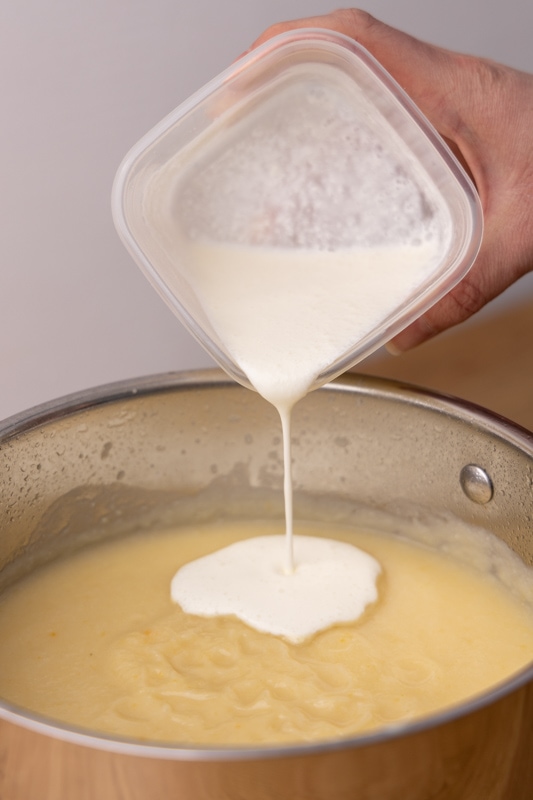
Soups with pasta, rice, etc.
Pasta, rice, and some other grains tend to become mushy when reheating, and even more so if frozen, defrosted, and then reheated.
While you might find that mushy pasta acceptable, you can also avoid the problem by cooking the pasta separately and adding it when you’re done reheating the defrosted soup. This way, the pasta doesn’t end up overcooked and mushy.
(The same approach helps when you’re cooking soup for a couple of days, and don’t plan on freezing it.)
Other cases
If neither is your case and the soup still turns out meh quality-wise after defrosting, another option is to freeze the broth (unless you’re using bouillon cubes), veggies, and what have you separately. You do all the peeling, slicing, and cutting in advance, freeze everything, and cook the soup after defrosting the ingredients.
It’s not nearly as nice as having a frozen soup ready for reheating after defrosting, but some of you might find it helpful.
A similar approach is popular in the meal-prep community. Instead of prepping meals for the week ahead, some people batch prep activities such as peeling and slicing, and cook the meals when they normally would.

Rules and Tips for Freezing Soups
First off, remember that soups expand as they freeze, so you shouldn’t overfill the container. Instead, leave about an inch or so of headspace so that the liquid has space to grow.
Second, if you’re freezing many soups, label each container. This way, you’ll know which container to grab instead of guessing between two similar ones in the freezer.
(I once had a small container of heavy cream and another one with buttermilk. As you might imagine, both looked pretty much the same after freezing. That ended up in a sudden change of plans after defrosting.)
Third, freeze soup in meal-sized portions. This way, you don’t end up with any leftovers after reheating.
Last, some people like to freeze soup flat in freezer bags. This way, soup takes as little space in the freezer as possible and is easily stackable.
If you go that route, place each bag into a bowl before pouring soup into it. This way, if the bag turns out leaky, you don’t have to clean up half of your kitchen. Plus, you don’t waste any soup.
How Long Does Soup Last in the Freezer?
Soups typically keep quality in the freezer for at least 2 to 3 months. You can, of course, freeze them for much longer, but the longer they sit frozen, the worse the overall quality will be after defrosting.
That said, this quality degradation is gradual. That means freezing the soup for an extra week or month won’t make that much of a difference.
And when you’re reheating soup that’s been frozen for like six months or more, try to find a way to freshen the taste a bit. A handful of fresh herbs, some pasta, or heavy cream can often make a noticeable difference.
Defrosting Soup
There are at least three good ways to defrost soup.
In the Fridge
You place the frozen container in the fridge and wait until it defrosts. Depending on the portion size, the process might take between 6 to 8 hours for small containers or freezer bags frozen flat to 24 hours or even more for large containers and pots.
This method is perfect if you have enough time to wait until the soup defrosts or if you didn’t portion the soup and you might need to refreeze some of it.
On the Stove
If you’re in a hurry, defrosting soup on the stove is an option.
First, place the bag or container in a bowl of warm (not hot) water for a few minutes so that the sides defrost enough to remove the soup from the container or bag. Then you transfer the frozen soup into a pot and warm it up on the stove until it thoroughly defrosts, then you reheat it.
When defrosting, consider the soup’s overall texture when choosing the heat setting. For thin soups, medium-high should be okay. But for creamy soups that are quite dense, you’ll probably have to defrost them on low and stir them often, so they don’t burn.
In the Microwave
Another option when you need the soup thawed as soon as possible is the microwave.
For starters, ensure the soup is in a microwave-safe bowl or container. If you haven’t frozen the soup in one, transfer it to a container that you can safely microwave first.
Then microwave on defrost or low in 30- to 60- second increments, and stir after every nuke to help spread the heat without having the exterior piping hot and the interior still frozen.
Cook and use immediately.
Last but not least, let’s talk about reheating soups.
Reheating Soup
You can reheat soups on the stove or in the microwave, depending on your preferences.
But no matter how you do it, and whether that soup was frozen or not, make sure you reheat it until it’s hot throughout and its temperature is at least 165°F (or 74°C).
If you’re not into running around with a food thermometer, bring the soup to a boil for 2 to 3 minutes. Or, if it’s a thick soup prone to scorching, bring it to a gentle simmer for those 2 to 3 minutes while stirring it constantly. That’s what you do when reheating lentil soup, for instance.
This way, any harmful bacteria that might be developing in the soup are killed off. That lowers the chances of food poisoning significantly.
When reheating, don’t keep the soup boiling or simmering without a lid for too long, so it doesn’t over-reduce. Or at least add some water, milk, or broth to account for the water that will evaporate.
Rotten Records: Share Your Snap!
Caught some food past its prime? Upload your photo to “Rotten Records” and help others spot the signs of spoilage. Every image makes our food community safer and more informed!
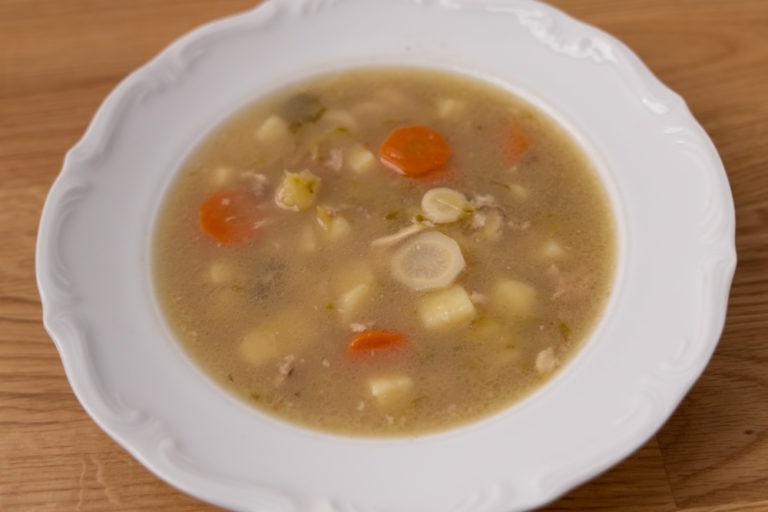


![How Long Does Quiche Last? [Storage, Shelf Life, and Spoilage]](https://www.doesitgobad.com/wp-content/uploads/Freshly-baked-quiche-768x512.jpg)
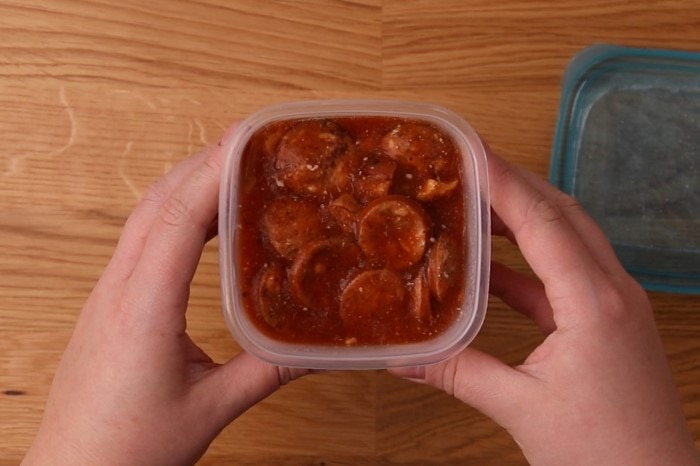
![How Long Does Meatloaf Last? [Storage, Shelf Life, and Spoilage]](https://www.doesitgobad.com/wp-content/uploads/Freshly-baked-meatloaf-768x512.jpg)